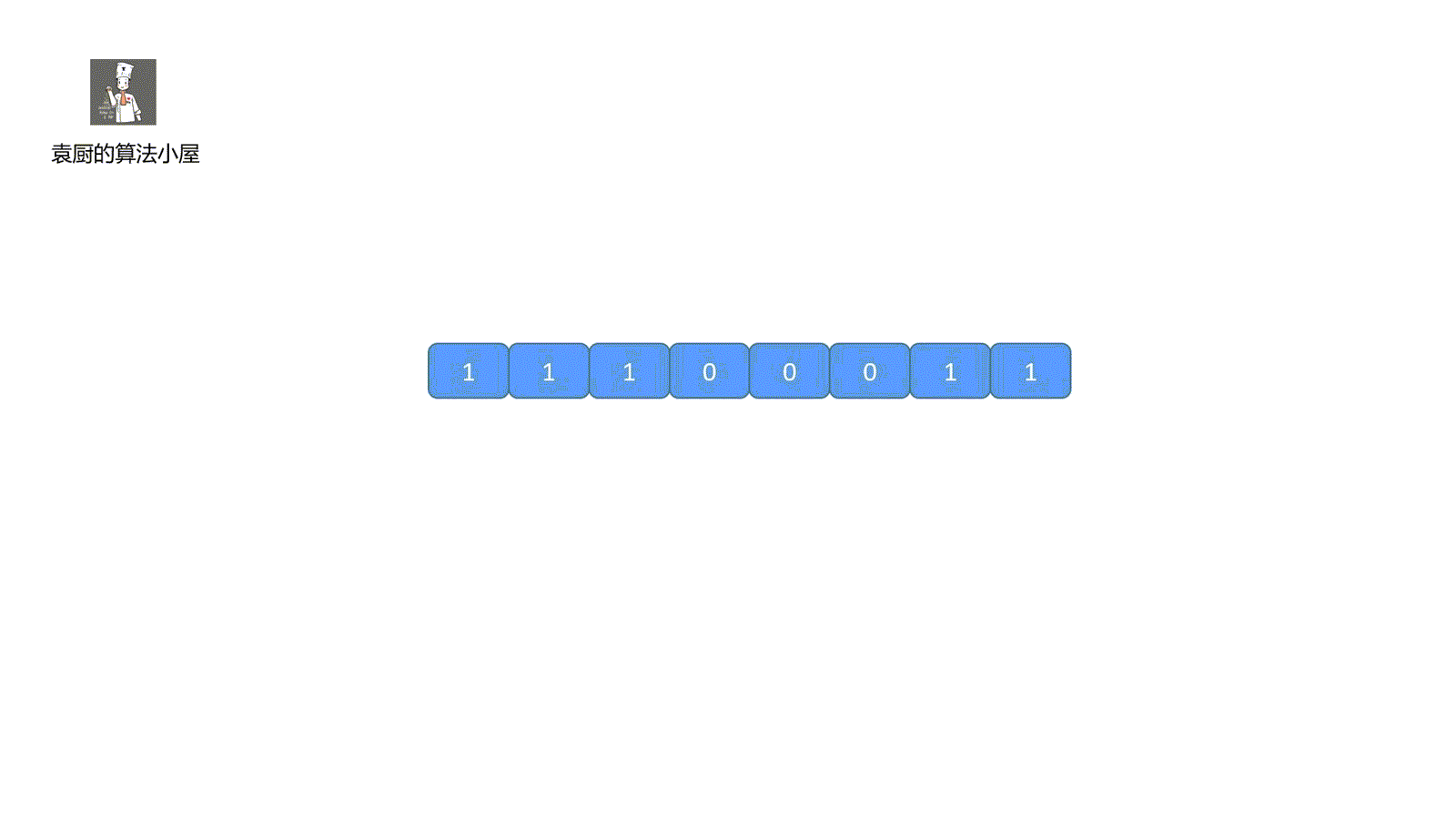如果阅读时,发现错误,或者动画不可以显示的问题可以添加我微信好友 tan45du_one ,备注 github + 题目 + 问题 向我反馈
感谢支持,该仓库会一直维护,希望对各位有一丢丢帮助。
另外希望手机阅读的同学可以来我的 公众号:程序厨 两个平台同步,想要和题友一起刷题,互相监督的同学,可以在我的小屋点击刷题小队进入。
给定一个二进制数组, 计算其中最大连续 1 的个数。
示例 1:
输入: [1,1,0,1,1,1] 输出: 3 解释: 开头的两位和最后的三位都是连续 1,所以最大连续 1 的个数是 3.
我的这个方法比较奇怪,但是效率还可以,战胜了 100% , 尽量减少了 Math.max()的使用,我们来看一下具体思路,利用 right 指针进行探路,如果遇到 1 则继续走,遇到零时则停下,求当前 1 的个数。
这时我们可以通过 right - left 得到 1 的 个数,因为此时我们的 right 指针指在 0 处,所以不需要和之前一样通过 right - left + 1 获得窗口长度。
然后我们再使用 while 循环,遍历完为 0 的情况,跳到下一段为 1 的情况,然后移动 left 指针。 left = right,站在同一起点,继续执行上诉过程。
下面我们通过一个视频模拟代码执行步骤大家一下就能搞懂了。
下面我们直接看代码吧
Java Code:
class Solution {
public int findMaxConsecutiveOnes(int[] nums) {
int len = nums.length;
int left = 0, right = 0;
int maxcount = 0;
while (right < len) {
if (nums[right] == 1) {
right++;
continue;
}
//保存最大值
maxcount = Math.max(maxcount, right - left);
//跳过 0 的情况
while (right < len && nums[right] == 0) {
right++;
}
//同一起点继续遍历
left = right;
}
return Math.max(maxcount, right-left);
}
}Python3 Code:
from typing import List
class Solution:
def findMaxConsecutiveOnes(self, nums: List[int])->int:
leng = len(nums)
left = 0
right = 0
maxcount = 0
while right < leng:
if nums[right] == 1:
right += 1
continue
# 保存最大值
maxcount = max(maxcount, right - left)
# 跳过 0 的情况
while right < leng and nums[right] == 0:
right += 1
# 同一起点继续遍历
left = right
return max(maxcount, right - left)Swift Code
class Solution {
func findMaxConsecutiveOnes(_ nums: [Int]) -> Int {
var left = 0, right = 0, res = 0
let len = nums.count
while right < len {
if nums[right] == 1 {
right += 1
continue
}
// 保存最大值
res = max(res, right - left)
// 跳过 0 的情况
while right < len && nums[right] == 0 {
right += 1
}
// 同一起点继续遍历
left = right
}
return max(res, right - left)
}
}刚才的效率虽然相对高一些,但是代码不够优美,欢迎各位改进,下面我们说一下另外一种情况,一个特别容易理解的方法。
我们通过计数器计数 连续 1 的个数,当 nums[i] == 1 时,count++,nums[i] 为 0 时,则先保存最大 count,再将 count 清零,因为我们需要的是连续的 1 的个数,所以需要清零。
好啦,下面我们直接看代码吧。
Java Code:
class Solution {
public int findMaxConsecutiveOnes(int[] nums) {
int count = 0;
int maxcount = 0;
for (int i = 0; i < nums.length; ++i) {
if (nums[i] == 1) {
count++;
//这里可以改成 while
} else {
maxcount = Math.max(maxcount,count);
count = 0;
}
}
return Math.max(count,maxcount);
}
}Python3 Code:
class Solution:
def findMaxConsecutiveOnes(self, nums: List[int]) -> int:
ans = i = t = 0
for j in range(len(nums)):
if nums[j] == 1:
t += 1
ans = max(ans, t)
else:
i = j + 1
t = 0
return ansSwift Code
class Solution {
func findMaxConsecutiveOnes(_ nums: [Int]) -> Int {
let len = nums.count
var maxCount = 0, count = 0
for i in 0..<len {
if nums[i] == 1 {
count += 1
} else { // 这里可以改成 while
maxCount = max(maxCount, count)
count = 0
}
}
return max(maxCount, count)
}
}C++ Code
class Solution
{
public:
int findMaxConsecutiveOnes(vector<int> &nums)
{
int s = 0;
int e = 0;
int result = 0;
int size = nums.size();
while (s < size && e < size)
{
while (s < size && nums[s++] == 1)
{
e = s;
while (e < size && nums[e] == 1)
{
e++;
};
//注意需要加1, 可以使用极限条件测试
int r = e - s + 1;
if (r > result)
result = r;
s = e;
}
}
return result;
}
};Go Code:
func findMaxConsecutiveOnes(nums []int) int {
cnt, maxCnt := 0, 0
for i := 0; i < len(nums); i++ {
if nums[i] == 1 {
cnt++
} else {
maxCnt = max(maxCnt, cnt)
cnt = 0
}
}
return max(maxCnt, cnt)
}
func max(a, b int) int {
if a > b {
return a
}
return b
}